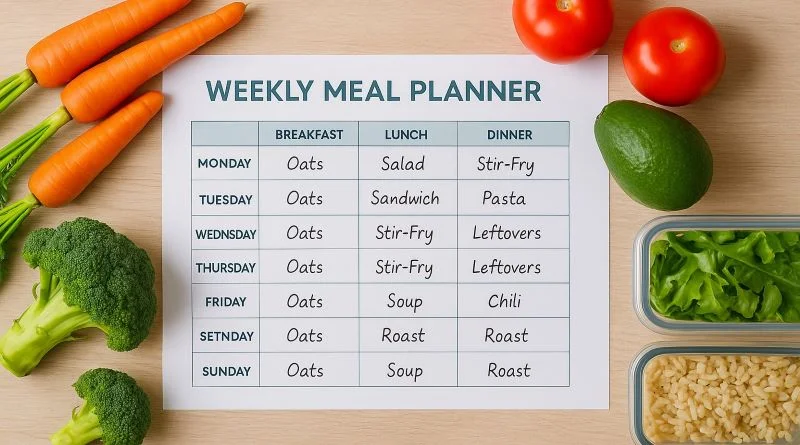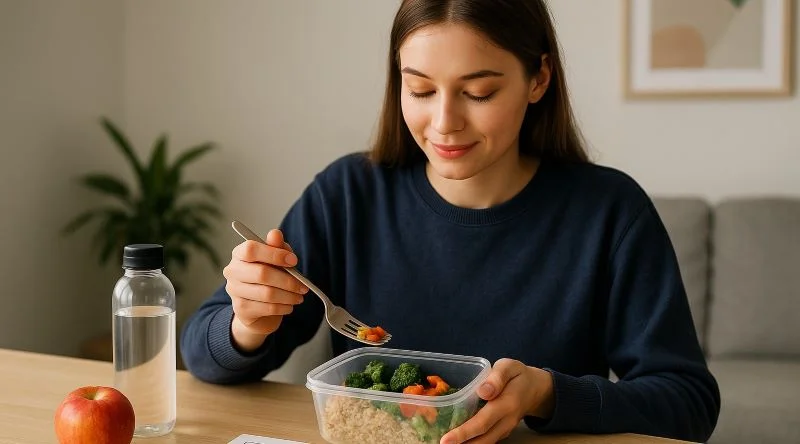
Eating healthy doesn’t have to be expensive!
In fact, with a little planning and smart shopping, you can nourish your body without draining your bank account. Whether you’re saving for the future, managing a tight paycheck, or just want to live healthier, meal planning on a budget is a practical and empowering skill.
💡 Curious how good nutrition can impact your financial life? Don’t miss these nutrition hacks that boost both productivity and success.
Why Budget Meal Planning Matters
Let’s be real—life is busy. Between work, family, and everything in between, it’s tempting to grab fast food or skip meals altogether. But these habits often cost more in the long run—both financially and health-wise.
Here’s the good news: affordable, nutritious meals are within reach. With the right plan, you can:
- Save money on groceries
- Reduce food waste
- Eat healthier consistently
- Avoid last-minute food splurges
- Gain control over your nutrition and budget
Let’s dive into how to make it happen.
1️⃣ Set a Realistic Food Budget
First things first: determine how much you can comfortably spend on food weekly or monthly. Consider your income, household size, and other expenses. Once you have a number, stick to it as closely as possible.
💡 Pro Tip: Use budgeting apps like Mint or YNAB to track your food spending.
2️⃣ Plan Your Meals Ahead of Time

Meal planning is the cornerstone of eating well on a budget.
Here’s how to start:
- Pick one day each week (like Sunday) to plan meals for the week.
- Check your pantry and fridge to use what you already have.
- Choose 3–5 go-to meals for dinner, then rotate ingredients.
- Plan for leftovers to minimize cooking and waste.
Create a weekly meal plan that includes:
- Breakfast (easy and quick)
- Lunch (packable or prep-ahead)
- Dinner (nutrient-dense and affordable)
- Snacks (budget-friendly options like fruit or homemade trail mix)
🥦 For guidance on balanced meals, visit the USDA MyPlate website.
3️⃣ Make a Master Grocery List to Cut Food Costs
Impulse buys kill budgets. Make a grocery list based on your weekly meal plan and commit to buying only what’s on the list.
Budget grocery list staples:
- Oats, brown rice, whole grain pasta
- Lentils, beans, canned chickpeas
- Frozen fruits and veggies
- Eggs, canned tuna, or rotisserie chicken
- In-season fresh produce
- Greek yogurt or low-fat milk
💡 Avoid shopping when you’re hungry—you’re more likely to overspend.
4️⃣ Shop Smart: Where and How You Buy Matters
Ways to stretch your food dollars:
- Buy in bulk: Get staples like rice, oats, or beans in large quantities.
- Go generic: Store brands often have the same quality for less.
- Use coupons and cash-back apps like Ibotta or Rakuten. These apps offer rewards for everyday grocery shopping—bonus savings without extra effort.
- Shop discount stores or local farmers markets.
- Stick to the outer aisles: That’s where the whole foods—like fresh produce, dairy, and meats—are usually found.
5️⃣ Cook at Home More Often

Eating out adds up fast. A $10 lunch here and a $15 dinner there quickly eats your budget. Cooking at home not only saves money—it gives you full control over ingredients and portions.
✅ Want more time and energy for cooking at home? Explore passive income ideas that support a healthier lifestyle.
Easy, cheap meal ideas:
- Stir-fried veggies with brown rice
- Chili with canned beans and ground turkey
- Overnight oats with banana and peanut butter
- Tuna salad sandwiches with a side of fruit
- Egg and veggie breakfast burritos
Cooking doesn’t have to be complicated. Start simple.
6️⃣ Embrace Meatless Meals
Meat is often one of the most expensive items on a grocery list. You don’t have to go full vegetarian, but incorporating a few meatless meals each week can seriously cut costs.
Protein-packed plant-based alternatives:
- Lentils
- Chickpeas
- Tofu
- Black beans
- Quinoa
7️⃣ Batch Cook and Meal Prep
Spend a couple of hours one day a week preparing meals in bulk. You’ll save time during the week and reduce your temptation to order out.
Meal prep ideas:
- Make a big pot of soup or chili
- Pre-cook rice, quinoa, or pasta
- Chop vegetables and store them in containers
- Portion meals into grab-and-go containers
This reduces weekday stress and food waste.
8️⃣ Avoid Food Waste (and Save Money)
Wasting food = wasting money.
Use these tips to keep waste to a minimum:
- Store produce properly to extend shelf life
- Label leftovers with dates
- Freeze extra portions before they go bad
- Repurpose leftovers into new meals (e.g., roast chicken → soup)
💡 Before buying more, use what’s already in your kitchen.
9️⃣ Use Simple, Healthy Recipes
You don’t need fancy ingredients or expensive cookbooks. Stick with easy meals using whole foods and basic spices.
Affordable healthy cooking tips:
- Use garlic, onions, and spices to add flavor
- Cook with olive or avocado oil instead of butter
- Limit processed sauces and seasoning packets
- Bake, steam, or stir-fry instead of frying
Simple is often healthier—and cheaper.
🍲 Need meal ideas? Browse Budget Bytes for simple, budget-friendly recipes.
🔟 Keep It Sustainable (and Realistic)

Don’t aim for perfection. It’s okay to grab takeout once in a while or eat leftovers two days in a row. What matters most is consistency, not perfection.
Real-Life Budget Meal Ideas
Here are a few cheap and healthy meal examples:
- Oatmeal with fruit and peanut butter
- Egg and veggie scramble with toast
- Lentil soup with whole-grain bread
- Stir-fried rice with frozen veggies and eggs
- Taco bowl with beans, rice, salsa, and greens
- Pasta with sautéed spinach, garlic, and olive oil
Delicious doesn’t have to mean expensive.
FAQs About Healthy Meal Planning on a Budget
Q: Is it possible to eat healthy for $50 a week?
A: Yes! With careful planning, shopping in bulk, and sticking to simple, whole foods like rice, beans, eggs, and seasonal produce, many individuals or couples can eat well on $50 a week.
Q: How can I make my meals more interesting without spending more?
A: Use herbs and spices, rotate your proteins, and experiment with global recipes (like lentil curry or veggie stir-fry). Cooking new styles of meals can be affordable and exciting.
Q: What are the best cheap, healthy snacks?
A: Great options include popcorn, carrots and hummus, peanut butter and apples, hard-boiled eggs, and homemade granola.
Conclusion: Eating Healthy Doesn’t Have to Cost a Fortune
Meal planning on a budget is about working smarter, not harder. With a little time and intention, you can eat delicious, healthy meals while sticking to your financial goals. It’s one of the best investments you can make—for your health and your wallet.
Ready to Take Control of Your Food Budget?
Start small. Choose one tip from this article and put it into action this week. Then build from there. You’ll be surprised at how much money—and stress—you save just by planning ahead.
🔗 Looking for cheap and nutritious grocery staples? Don’t miss our post: 10 Cheap Nutritious Foods That Won’t Break the Bank.
💬 Have a favorite budget-friendly recipe or meal prep tip? Share it in the comments below!

Your article, “Meal Planning on a Budget: 10 Smart Ways to Eat Healthy and Save Money,” is informative, engaging, and highly practical, offering readers clear, realistic strategies to eat well without overspending. It balances friendly tone with actionable advice, making complex habits like meal prepping and budgeting feel approachable and sustainable.
The layout is easy to follow, with helpful tips like using leftovers, shopping smart, and embracing meatless meals. To enhance it further, consider adding links to printable tools or meal plan templates, and briefly touch on global cuisines for affordable variety.
Overall, it’s a well-crafted, empowering guide that effectively supports readers in making healthy, budget-conscious choices.
Hi SJ,
Thank you so much for your kind and encouraging feedback! I’m really glad to hear that the article felt both practical and approachable—making healthy eating affordable is definitely a goal I’m passionate about.
I love your suggestions about adding printable tools and meal plan templates. That’s a wonderful idea to help readers put these tips into action more easily! And including a bit about global cuisines for variety would add such a fun and tasty twist to budget-friendly meals.
I’ll definitely keep these ideas in mind for future updates to make the content even more helpful. Thanks again for taking the time to share your thoughtful insights—it means a lot!
Wishing you joy and ease in your healthy eating journey! 🥗✨
Meal planning on a budget has been a game-changer for me, especially during tight financial months. I’ve noticed that prepping meals around seasonal produce and bulk staples like rice and beans not only saves money but also reduces food waste significantly.
One thing I still find challenging is balancing variety and nutrition without overspending. Do you recommend rotating meal plans weekly or monthly to keep things fresh without breaking the budget?
Also, I’d love to hear your thoughts on how to involve kids in the planning process to encourage healthier choices.
Hi Slavisa, thank you so much for your thoughtful comment!
I’m glad to hear meal planning on a budget has been a game-changer for you—seasonal produce and bulk staples are absolute lifesavers when it comes to saving money and minimizing waste.
You bring up a great point about balancing variety and nutrition. Personally, I recommend rotating meal plans on a bi-weekly or monthly basis. This gives you enough diversity to avoid mealtime boredom while still allowing you to shop smart with bulk items and seasonal deals.
You can also create a “mix and match” list of proteins, grains, and veggies that work well together—this gives flexibility without requiring a totally new menu each week.
As for involving kids, absolutely! It’s a great way to teach healthy habits early on. Some ideas:
1. Let them pick a veggie or fruit of the week.
2. Give them age-appropriate prep tasks (washing produce, stirring, or even assembling lunchboxes).
3. Try theme nights like “Taco Tuesday” or “Build Your Own Bowl” where they can customize their meals within healthy options.
Thanks again for engaging with the post—your insights add so much value to the conversation!